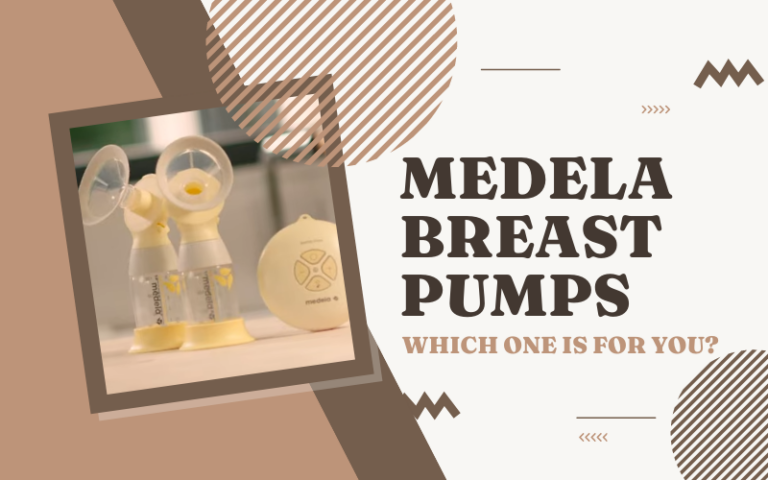If you’re looking for Medela breast pump comparisons, you probably want to know which model is the best.
This guide will help you with that. But first, a small history about Medela:
A Brief History of Medela
The tiny country of Switzerland is famous all over the world for its cheese. It is also popular for its precision watches.
Very few people, however, are aware that the big name in the mother-and-baby-care industry, Medela, has its origins in Switzerland too.
Founded by Olle Larsson in 1961, Medela came to the U.S. shores around 1984. This was after making a name for itself in European markets for twenty-five years.
Medela today is synonymous with the best of what America stands for. Highest quality products and services, and deep commitment to its chosen field of activity.
Medela was the first corporation to bring to the attention of the United States’ businesses the need for providing amenities to working mothers who breastfeed away from their homes.
Thanks to Medela’s efforts, quite a few states have taken proactive action towards making the workplace more amenable for mothers who require an accessible and private location for carrying out their milk expression.
Medela also took the initiative of highlighting the advantages of feeding the infant expressed milk. Compared to formula milk.
Today, a majority of mothers prefer to feed their children from their own breasts. And go in for formula milk only as a last resort.
Medela’s Breastfeeding Products
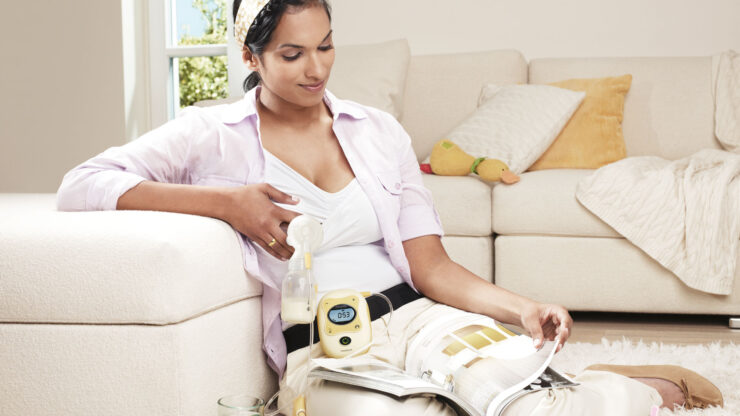
The company has a mind-boggling array of breastfeeding products in its repertoire. Each product goes through production keeping in mind the various situations that post-partum mothers go through.
From the time the baby feeds for the first time to the time he/she starts eating solid food. And when it does not need breastmilk any longer.
The entire spectrum in breast pumps is available for the mother to choose from.
Hospital-grade electric pumps, handheld battery-driven breast pumps, mini- electric models, and manual devices. All with in-depth instructions about their usage for the discerning mother.
The Need for Breast Pumps
Breast pumps have become an essential component of post-partum life for breastfeeding mothers. Though, they are not for working moms only. They serve a purpose in medical situations too.
For children with some medical problems, doctors often advise against nursing them at the mother’s breast.
Parents who do not want to take the formula feeding route, prefer breast pumping as a logical option. Medela breast pumps play a role in such situations, with a variety to choose from.
Storing Breast Milk With Medela Breast Pumps
Then there are mothers who, when planning for an evening out, prefer to store milk expressed using breast pumps in freezers. And leave instructions with the babysitter about their usage.
An economical, but very effective, manual pump is available from Medela for such mothers. In some situations, mothers face a condition known as engorged breasts.
Here, the breasts become too full of milk, leading to tightness in the tissues. This is quite painful for the mother.
The child who has been nursing at the breast, also instinctively feels the abnormality, and finds it difficult to latch on to the nipple.
Medela’s breast pumps gently massage the tissues, and lead them to dis-engorge gradually. The company has come out with variants of the basic breast pump that addresses this. And many other situations that mothers have to face.
Each device comes with its own instruction manual.
The Verdict
Besides the written word, the company has developed a network of lactation consultants across the country. These professionals counsel mothers on the best pumps that can take care of their needs.
These professionals also provide feedback on a continuing basis. This then goes into the company’s self-help literature.
Mothers of yore were less fortunate in terms of the depth of expertise available to them. Today’s mother is more informed and more educated, thanks to the efforts of socially responsible corporates such as Medela.
Medela Electric Breastpumps
Medela has an awesome range of breastpumps that a quality-conscious breastfeeding mother can choose from.
Though this depends on the situation she is in.
For mothers who would like to go in for electric or battery-operated pumps, the company has four major models to offer.
The Freestyle Double Electric, the Swing Single, the Harmony, and the Symphony breast pumps.
Each model has its own characteristic features. The mother can select the one that suits her best. The company recommends the use of the above models for short-term absences from the baby.
1. Freestyle Double Electric Breast Pump

The Freestyle Double Electric breast pump, as the name suggests, has two breast shields. Each one goes on each breast. And expression from both the breasts is simultaneously carried out.
However, performing the expression on both the breasts or one at a time is up to the mother to decide. There are two C.I. 5V alkaline batteries that support the pump.
While operating on batteries, as against a regular power supply, the mother should remain alert towards any slowing down of the pumping cycle. This often happens due to wearing down the batteries.
This slowing down may cause some discomfort because the vacuum will be held longer on the breast.
The breast shield comes along with a selection of inserts for nipples that are small to medium in size. Moms may experiment with pumping with and without inserts, to determine which option is more comfortable.
There are six adjustable vacuum levels on the breast pump. It is advisable to begin pumping from the minimum vacuum level (position 1 on the lever).
And then increasing the vacuum gradually so as not to compromise comfort. And at the same time, the flow of milk goes up.
With practice, the correct vacuum level becomes familiar. It’ll also be easier to place the lever in a permanent position for quicker pumping.
The breast pump has a warranty of three months against any defects for all its parts and six months on the pump. In case of any replacement due to wear and tear, parts are available for a few hundred dollars for the motor unit.
Professional Medela breastpumps
Medela is a company that has made continuous improvements in technologies for breast pumping its mission.
So, it is not surprising that their repertoire contains such a rich variety of equipment for the breastfeeding mother to choose from.
Amongst the string of categories, each of which further contains a mindboggling number of models is a category “the Professional series”.
They all have a patented technology called Natural Expression in them.
The following models are part of the Professional series – “Pump In Style Advanced Backpack”. followed by a more staid, “Pump In Style Advanced”. And then the “Pump In Style Original” and finally the “Pump In Style Traveler”.
It is the “Natural Expression” technology that distinguished this series from the rest of the Medela stable initially.
Models that succeeded it, too, incorporated the technology later, as its effectiveness became proven and accepted by its customers.
The Research Behind Natural Expression
Natural Expression evolved as a result of studies carried out by Dr. Peter Hartmann, a leading scientist, and lactation expert.
Dr. Hartmann’s research brought to light for the first time the sucking pattern that characterizes the infant’s efforts of drawing milk from the mother’s breast.
The infant has an instinctive method that nature builds into its genes, wherein it starts sucking at the nipple quite rapidly at a very high-frequency rate.
The moment the milk ejection begins, the infant automatically and quite abruptly drops to a slower sucking rate. And since the swallowing of the milk entering its buccal cavity also begins to take place side-by-side.
The nursing rhythm of the baby, known as two-phase cycling, led to the design of a prototype that mimics this very rhythm.
Pump In Style Original
The “Pump In Style Original” breast pump brought about a revolution in this industry. This is due to the superior quality and comfort that it extended to the mother.
It has a manual operation, and at the same time. And it has the facility to be driven by batteries and regular electric supply.
There are three cooling elements, besides a built-in cooler compartment to store the milk. The kit comes with a double pumping accessory kit, too.
2. Pump In Style Advanced

The “Pump In Style Advanced” and the “Pump In Style Advanced Backpack” differ only in the looks and features of the carry bag that the latter has.
The “Backpack” version has a trendy, sporty look, and is surely an attraction for the breastfeeding female with a similar disposition!
The stylish black microfiber bag discreetly fits in all the parts of the kit quite comfortably. This includes the motor unit, the cooler carrier, the AC adapter, four collection containers and lids, a double pumping accessory kit, etc.
Pump In Style Traveler
The “Pump In Style Traveler” version is quite ergonomic in terms of design and is good for traveling moms and dads.
There is a removable motor that can remain at work. It also includes a removable cooler carrier, which you can use to transport the daily quota of breastmilk to home or daycare.
For added convenience, the Traveler kit comes with an extra DayCarrier. Thus, allowing the mother to carry the regular kit with her to express and store milk at the workplace.
3. Medela Little Hearts Breastpump
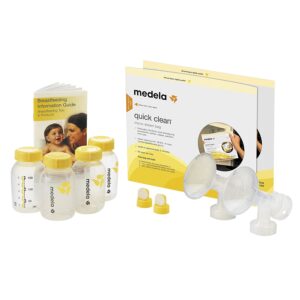
In a world of quite sophisticated breast pumps, with “smartcards” and electronic wizardry embedded in them. It includes others with heavy-duty motors and rugged battery packs that can go on working non-stop.
For quite some time, the Medela Little Hearts Manual Breastpump appears quite incongruous. But its beauty lies in its simplicity and ease of use.
The pump has no ambitions of competing with the hospital-grade variety. It feels quite out-of-place in the hands of demanding mothers who have frequent expression requirements which have to be completed quite fast, too!
Instead, Little Hearts is completely at home with the stay-at-home mother, who has only occasional use for pumping, as she is always around the child, available to nurse whenever the hunger pangs begin.
Perhaps the mother has to go out somewhere for a very short period of time, and might be late in returning?
Well, she can express her milk using this cute little pump, store the milk in the refrigerator, and instruct the person taking care of the baby in her absence to feed her child on time,
Features of the Medela Little Hearts
Vacuum Regulator
This helps in suckling at the breast tissues near the nipple and the areola. Initially, you can set the regulator to “MIN”.
Gradually, as you start pumping, the regulator ring can go towards “MAX”. This tells you the vacuum pressure that you are most comfortable with.
The initial pumping stimulates the breasts, enough for the milk to begin flowing. The higher the vacuum level you can maintain, without compromising your comfort, the better the flow will result.
After about five minutes of pumping, you can switch the device to the other breast. This back and forth switching should continue several times, till such time that the breasts feel to be sufficiently empty.
The Suction Power
Sometimes the suction appears to be low, or not present at all. This might be usually due to some leakage in the cylinder/piston fittings, or the valve/container fittings.
In such a case, you may disassemble the unit and reassemble it again, this time fastly securing the connections.
Another reason could be that the membrane is not lying flat on the surface of the valve in the breast shield; resulting in the air escaping.
You can remove the shield, and the valve and membrane rechecked. If neither seems to be the case, and the valve and the membrane appear to be clean too.
Then it is best to contact the nearest customer care center of Medela for further help. The company provides a ninety-day warranty on Little Hearts.
4. Medela ManualEase
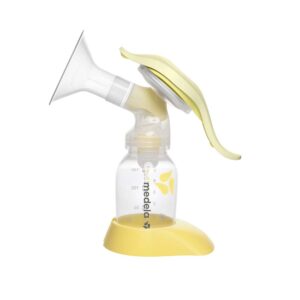

Medela, as a company, prides itself on coming out with newer and more innovative products in the breast pumping sector.
It is able to do this because of the continuous feedback that it proactively gathers from the breastfeeding mother community from all over the country.
The ManualEase breast pump, a manually operated product, came out of the company’s factory floor in response to such suggestions.
The ManualEase design is quite compact and handy. What makes it unique is its table-top feature. This allows you to move the pumping action to the top of the table, separate from the breast shield and the container.
This makes it quite convenient for any family member to assist in the pumping operation. ManualEase is especially useful for mothers who wish to store milk for later use.
Mothers who are always around, and can nurse the child whenever it demands, may use this pump occasionally when she has to stay away from the child for an extended period of time.
And might not be able to return before the next hunger pang.
If the nipples have become sore due to wrong tugging by the child or some other factor, ManualEase helps in continuing with expressing the milk, while healing is taking place.
There is a condition known as engorgement, in which the breasts become so full of milk, that the tissues tighten and milk flow is painful.
In such situations, when even the child is unable to connect to the breast comfortably, ManualEase helps by gently massaging the tissues till the point of disgorgement.
Assembling the ManualEase
Assembling ManualEase is deceptively simple. Before assembling the parts for the first time, it is advisable to sterilize them in boiling water for about twenty odd minutes, then rinsing and air-drying them.
The parts fit into each other snugly, and each of them should be tightly fit together such that no air escapes from any loose couplings.
The equipment has six adjustable vacuum levels, with position 1 being the minimum. Initially, the position may be maintained to level one, and then increased gradually.
As the vacuum causes a tugging at the breast tissues, there is always the risk of a higher vacuum causing injury. For this reason, the vacuum level should be maintained only to the point where comfort is not compromised.
If the table holder has to be used, simply fasten the piston/cylinder to the table holder, and connect the tubing’s ends between the piston/cylinder and the breast shield frame.
With one hand holding the breast shield firmly in place, the other hand can pump the piston resting on the table.
The tabletop might be fixed on a wall, too; in fact, any position where it is convenient for the mother to pump. By changing the position of the pump, the mother does not get fatigued by repeated hand operations.
The Verdict
ManualEase is yet another attempt by Medela to put the breastfeeding mother at ease.
World over, mothers prefer to feed their bundle of joy with their own milk, rather than industrial, or formula milk. ManualEase helps them fulfill their wish.
5. Medela SpringExpress
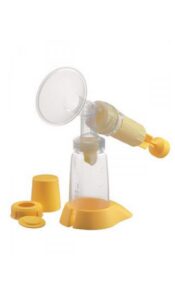

The Medela SpringExpress is a manually operated breast pump with a difference. The difference lies in a patented spring mechanism that goes into the pump assembly.
This spring mechanism makes it easy for the mother to pull out of the piston, easier than it would be with other manual pumps.
Due to the natural repulsive action of the spring, a vacuum is created quite efficiently, especially in the early stages of pumping, when letting down is not yet begun, and the breast tissues are still being stimulated.
The mother can increase the frequency of the suction by pumping more rapidly.
When the milk begins to flow, she can reduce the vacuum level, again manually, and milk is drawn in a fashion that exactly imitates the suckling action of the nursing child.
Who is it for?
SpringExpress is especially useful for mothers who are separated from their infants for a very short period of time.
Working mothers, who are away from the child the whole day, might have to go for a hospital-grade, or electric/battery-operated version to ensure speed of operation.
The same is the case with mothers who have to express milk through a breast pump very frequently, perhaps up to three to four times a day.
But, if the mother intends to use a breast pump only occasionally – perhaps she is going out in the evening and might not be back before hunger pangs hit the child – then SpringExpress is the perfect solution.
It is also an ideal equipment for mothers with sore nipples, which especially first-time mothers have to face. The child’s suckling at the nipples is unbearable to the mother; yet, the child “must” be fed breast milk “only”, and not any other variety.
SpringExpress comes to the rescue of this mother. Then, there are problems of engorgement or mastitis, when the flow of milk is obstructed either because the tissues are too full, or the duct is clogged.
SpringExpress gently massages the breast tissues near the nipple and areola, such that declogging and disgorgement take place, and normal nursing can be resumed.
Cleaning before use
Prior to each use, the different parts of the equipment, such as the breast shield, the valve, membrane, and the container should be disassembled and washed in soapy water and rinsed well.
Subsequently, they should be dried in the air. Medela also offers “Micro-Steam” bags for daily kit disinfection. Special, anti-bacterial Wipes are also available for cleaning the parts.
All this exercise ensures that the milk that goes into the child’s tummy is of top quality, without contamination.
The Piston
The Piston/Cylinder assembly should be looked after well. After every few pumpings, the cylinder, the rubber seal and the vacuum regulator must be cleaned with lukewarm soapy water.
This enables these parts to continue working efficiently. A solution of vinegar and water is also suggested in place of soapy water. The rubber seal should be perfectly dry before being installed back in place.
The milk thus collected after a session with SpringExpress may be stored in a refrigerator, where it can hold good for about a week’s time.
The suction in the pump is very vital. In case any problem with the suction is detected, the customer care center of the company may be contacted for a quick resolution of the problem.
6. Medela PedalPump
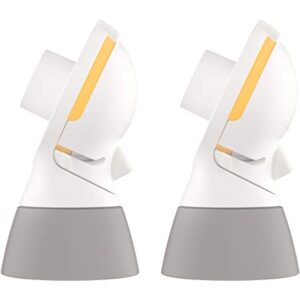

When it comes to a variety of designs and models for breast pumps, Medela, Inc, has few equals. The company has a mind-boggling range of equipment, each with its own unique features, and each geared towards the breastfeeding mother with specific requirements.
It has perhaps not excluded any situation that any woman in a post-partum situation, with a baby at her breasts, might find herself in.
The Medela PedalPump is one such model. As the name suggests, the pump is not powered by the arm or hand, but by the leg and foot.
The strong muscles in the leg and foot make the pumping work quite easy. In the case of a single pump, only one hand is occupied in holding the breast shield, leaving the other hand free.
In fact, because of the pedal, this is the only manual pump that allows both the breasts to be pumped simultaneously!
Features of the Medela PedalPump
The PedalPump kit comes with a special-purpose spring, trademarked as ExpressSpring by the company. This ExpressSpring is inserted into the cylinder/piston assembly, which is then fastened on the pedal.
The breast shield can be connected to bottles or CSF bags. For nipples that are smaller or medium size, inserts of the appropriate size may be placed in the shields.
One end of the tubing is connected to the back of the breast shield, and its other end is connected to the pump connector fastened to the pedal.
There are appropriate settings on the cylinder that can be adjusted for single as well as double pumping.
Operating the PedalPump
While sitting in a relaxed position, the foot should be positioned on the pedal. By raising and lowering the pedal, pumping operation starts.
Initially, the vacuum level should be set to a minimum. Gradually, this level may be increased; and with each change in the level, you will feel that the pull of the breast towards the shield has also gone up.
Without compromising on comfort, the vacuum level should be increased to the extent possible. This ensures better milk flow and more copious collection.
Verdict
Such a pump is quite useful when the frequency of expression is not very high.
When the mother is around most of the time, available to nurse the child at its beck and call; but needs to get away for a few hours once in awhile; the PedalPump comes in handy.
All that the mother has to do is to pump a few ounces of milk in a container and keep it in the refrigerator, with instructions to the person taking care of the infant to feed it on time.
It is advisable to store the milk at ordinary room temperature, only if it is surely going to be consumed within the next few hours; otherwise, there is always the risk of bacterial contamination.
7. Medela ManualElectric
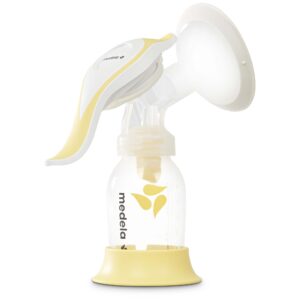

After creating and launching rugged electricity-driven pumps such as Lactina and Classic in the market, Medela began receiving feedback from their valued customer – the breastfeeding mother – about their efficacy.
The beauty of Manualectric is that it has all the features packed into it that are the hallmark of Medela machines.
It has the versatile power of the ExpressSpring mechanism in its cylinder/piston assembly. This spring allows the mother to have a higher frequency and more efficient vacuum levels.
Plus, if the mother has to upgrade to a daily-usage model such as the Lactina or the Classic, the Manualectric comes in handy there, too.
Who is it for?
ManualElectric is quite useful in scenarios where the mother has to leave the child only occasionally.
If she has to go away from the child for an extended period of time and is not quite sure whether she will be able to return before the child starts getting hungry, this model comes in handy for expressing milk and storing it in containers.
However, if the mother has to express milk several times, maybe four to five or more, in a day, then it is advisable to go in for the electricity- or battery-driven options available from Medela.
Similarly, a working mom, who might be spending up to eight hours or more at her workplace, will not find this model very useful, since, being manual, a lot of her valuable time will be spent in expressing milk.
There are a few other cases where the child has some condition in its jaw that prevents it from latching on to the breast properly.
Any attempts at making such a child suckle at the breast may only lead to injury to the breast tissues.
8. Medela Classic
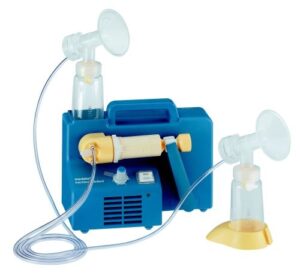

When the mother has to stay away from the child for an entire workday, for example, and/or there is a frequent need for expressing in one day; an industrious Classic comes to her aid.
The baby’s natural sucking pattern is what the Autocycle technology is about. And that is in the Medela Classic.
When the Classic starts functioning, this technology creates the exact sensation of the actual child suckling at the breast for the mother.
The Hydrophobic filter
An interesting feature of the Classic model is a hydrophobic filter that fits on the pump connector, between the pump and the container.
This filter inhibits the overflow of milk into the Electric pump while allowing air to flow through. This happens because, the moment any liquid comes in contact with the filter, it becomes impermeable.
The filter begins to work again only after it has been washed and dried. This feature singularly prevents any damage to the pump circuitry due to any contact with liquid.
The company’s brochures are quite specific about the cleaning methods you can use for the filter. It’s important to note that you shouldn’t use soap and abrasives in the cleanup.
You should make sure you don’t touch the fabric part of the filter. I recommend you air dry, which takes 2 to 3 hours or use a hairdryer, which takes 10 minutes.
Single and double pumping capabilities
Classic has the facility for both single well as double pumping. It is, however, for the mother to decide whether to go in for double pumping or not.
Research tells us that double pumping helps in increasing hormone secretions that stimulate lactation in the mother’s body, resulting in copious milk flow when expression starts.
Before switching on the pump, you should set the suction regulator on the kit to the minimum.
This ensures that there is no pulling at the breast tissues, and consequently no discomfort when the motor starts. Gradually, you should increase the regulator, which will cause suction to increase.
This suction stimulates the breast tissues near the areola in exactly the same fashion that the child does, when nursing at the breast. When the milk begins to express, the regulator may be kept stable.
Verdict
In case the baby is born premature or sick, it may not be medically stable enough to nurse directly at the breast.
In such a situation, there is always the risk that the mother’s milk supply may stop if there is no continuity in the expression of milk.
It is strongly advisable to begin pumping with the Classic within the first 24 hours after birth. Pumping for a minimum six to eight times every twenty fours is ideal, during such times.
However, there are cases where a health professional might tell you to delay pumping until such time that she recovers from giving birth. Here, a trade-off between recovery-time and milk supply-availability-time needs to be critically established.
There are also instances when the amount of milk you express is much more than the present demands of the child. In such cases, you can store the extra milk in freezers or cooler packs for later use. In all these situations, the Medela Classic assists in all ways, every step of the way.
If these weren’t enough, check out some other picks from Amazon also:

